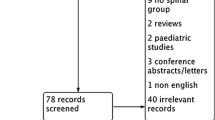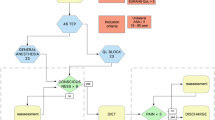Abstract
Background
Laparoscopic total extraperitoneal (TEP) inguinal hernia repair is as efficacious as the open Lichtenstein procedure, can be learned with proper training, and causes less postoperative pain, better cosmesis, and earlier return to work. The one major factor preventing the widespread acceptance of TEP is the requirement for general anesthesia (GA). In contrast, open hernia is performed using local or regional anesthesia, thereby having the advantage of quicker recovery, decreased postoperative nausea and vomiting (PONV), fewer hemodyanamic changes, reduced metabolic responses to surgical stress, and better muscle relaxation. This study attempted to evaluate whether laparoscopic TEP can be performed under less invasive anesthesia, such as regional anesthesia, and to determine its feasibility and limitations
Methods
All total of 22 male patients were studied between January 2002 and March 2003 in a tertiary care referral hospital. Epidural anesthesia with 2% lignocaine with adrenaline (Adr) was given via a lumbar epidural catheter, achieving a sensory level of T6. The standard technique for TEP was followed, using three midline infraumbilical ports.
Results
Twenty-two patients (20 unilateral, 2 bilateral) underwent operation. The mean operating time was 67.8 ± 18 (range, 40–110) min. All 22 cases were started with epidural anesthesia, 7 of which (31.9%) were converted to GA; the other 15 (68.1%) were completed under epidural anesthesia. All cases were successfully completed laparoscopically, and there were no conversions. There were no intraoperative complications. There was no significant difference between the cases conducted under epidural anesthesia (67.6 ± 23 min) and those converted to GA (69.3 ± 7.3 min). There was no statistically significant difference between the conversion rates of smaller versus larger hernias in this study (p value 0.22). A significant association of success of the procedure was seen with a sensory level of T6 and above (2/15 conversions to GA; i.e., 13.3%) and cases with a sensory level below T6 (5/7 converted; i.e., 71.4%) and adequate epidural catheter length (p = 0.015). Prevention and management of pneumoperitoneum and subsequent shoulder-tip pain was the key to preventing conversions (6 of 9 converted to GA; i.e., 67%; p = 0.006). There were no significant postoperative complications, and no recurrences were noted during a mean follow-up period of 29 months (range, 20–36 months).
Conclusions
From the present study it is clear that TEP is possible under epidural anesthesia provided a minimal sensory level of T6 is achieved. To achieve that level, an appropriate higher site for catheter insertion and/or adequate intraepidural catheter length needs specific attention. Pneumoperitoneum, shoulder-tip pain, intraoperative straining, and inadequate preperitoneal space are factors whose interplay leads to conversion to GA. The size of the hernia is not related to pneumoperitoneum or conversion to GA.

Similar content being viewed by others
References
Amid PK, Shulman AG, Lichtenstien IL (1995) An analytical comparison of laparoscopic hernia repair with open “tension free” hernioplasty. Int Surg 80: 9–17
Azurin DJ, Go LS, Cwik JC, Schuricht AL (1996) The efficacy of epidural anaesthesia for endoscopic preperitoneal herniorraphy: a prospective study. J Laparoendosc Surg 6: 369–373
Champault GG, Rizk N, Catheline JM (1997) Inguinal hernia repair: totally preperitoneal approach vs Stoppas operation, a randomized trial of 100 cases. Surg Laparosc Endosc 7: 445–450
Collins VJ (1993) Epidural anaesthesia. In Principles of Anaesthesiology: General and Regional Anaesthesia, vol. 2, 3rd edition, edited by Library of Congress Press. Pennsylvania, pp. 1571–1610
Hiekkinen TJ, Haukiporo K, Koivukangas P, Hulkko A (1998) A prospective randomized outcome and cost comparison of totally extra peritoneal endoscopic hernioplasty versus Lichtenstien hernia operation among employed patients. Surg Laparosc Endosc 8: 338–344
Johannson B, Hallerback B, Glise H (1999) Laparoscopic mesh vs. open preperitoneal mesh vs conventional anterior technique: a multicentric randomized trial. Ann Surg 230:225
Joris JL (1994) Anaesthetic management of laparoscopy. In Anaesthesia, vol 2, 4th edition, edited by Miller RD. Churchill Livingstone, New York, pp. 2011–2027
Lal P, Kajla RK, Chander J, Ramteke VK (2004) Laparoscopic total extraperitoneal (TEP) inguinal hernia repair: overcoming the learning curve. Surg Endosc 18: 642–645
Lal P, Kajla RK, Chander J, Saha R, Ramteke VK (2003) Randomized controlled study of laparoscopic total extraperitoneal versus open Lichtenstein’s repair. Surg Endosc 17: 850–856
Liem MS, Graaf YVD, Steensel CJV, Boelhouwer RU, Clevers G-J, Meijer WS, Stassen LPS, Vente JP, Weidema WF, Schrivers AJP, van Vroonhoven TJMV (1997) Comparison of conventional anterior surgery and laparoscopic surgery for inguinal hernia repair. N Engl J Med 336: 1541–1547
Memom MA, Fitzgibbons RJ Jr (1998) Assessing risks, costs, and benefits of laparoscopic hernia repair. Annu Rev Med 49: 95–109
Pullyblank AM, Carney L, Brandon F, Dixon AR (2002) Laparoscopic inguinal hernia repair: A NICE operation. J R Coll Edinb 47: 630–633
Spivak H, Nudelman I, Fuco V, Rubin M, Raz P, Peri A, Lelcuk S, Eidelman LA (1999) Laparoscopic extraperitoneal inguinal hernia repair with spinal anaesthesia and nitrous oxide insufflation. Surg Endosc 13: 1026–1029
Watkin D (2002) Why NICE does not recommend laparoscopic herniorraphy? BMJ 325:339
Author information
Authors and Affiliations
Corresponding author
Rights and permissions
About this article
Cite this article
Lal, P., Philips, P., Saxena, K.N. et al. Laparoscopic total extraperitoneal (TEP) inguinal hernia repair under epidural anesthesia: a detailed evaluation. Surg Endosc 21, 595–601 (2007). https://doi.org/10.1007/s00464-006-9050-6
Received:
Revised:
Accepted:
Published:
Issue Date:
DOI: https://doi.org/10.1007/s00464-006-9050-6




